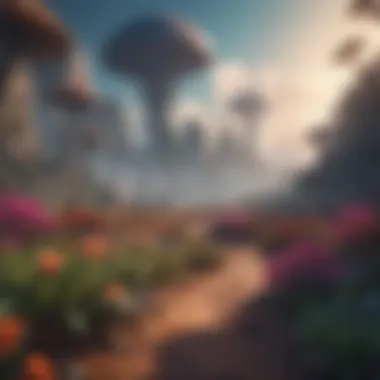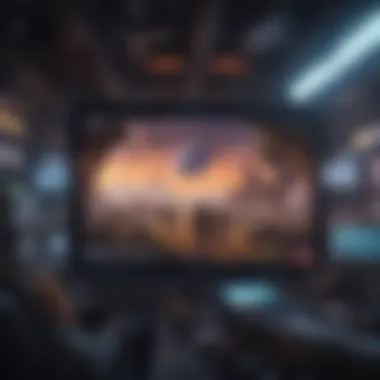Exploration of Alien Worlds in NFT Gaming


Intro
The intersection of alien worlds and NFT gaming is an intriguing frontier, vibrating with endless possibilities. Video games have always had a knack for creating realms far beyond our standard earthly experiences; now, with NFT technology, these virtual places come loaded with unique opportunities for ownership and economic interaction.
Picture this: digital landscapes teeming with extraterrestrial flora and fauna where every asset—from a rare weapon to a piece of land—possesses a unique identity, facilitated through NFTs. This concept doesn’t just bring novelty; it shakes the very foundation of gaming and ownership. As we dive deeper, we will untangle how these alien environments not only challenge our understanding of play but also unlock new economic structures that reshape user experiences and creator dynamics.
Thus, we turn our gaze toward market trends and analysis to glean how this burgeoning sector is evolving and what signals it offers us regarding future investments and engagement.
Prelims to NFT Gaming
In the digital landscape, NFT gaming stands out as a monumental shift in how players interact with virtual worlds. It introduces a new layer where ownership isn’t just about having a user ID and a password, but rather about possessing unique digital assets that one can buy, sell, or trade. This is crucial because it brings a tangible sense of value to virtual items—be it skins, weapons, or even virtual land.
NFT games bring forth a blend of traditional gaming mechanics with the innovative nature of blockchain technology. Players no longer rely solely on centralized servers to dictate what they own or how they play. Instead, they enjoy autonomy, as ownership is securely recorded on the blockchain.
The significance of this revolution cannot be understated:
- True Ownership: Players own their in-game assets, unlike conventional games where the publisher retains all rights.
- New Revenue Streams: Gamers can monetize their skills and collectibles, creating an ecosystem where both play and profit coexist.
- Community Dynamics: Players often rally together, fostering communities that extend beyond individual games.
This discussion will set the stage for deeper exploration into how alien worlds in NFT gaming are reshaping interactive experiences, driving economies, and ultimately, fostering a new digital culture.
Overview of NFT Concepts
NFTs, or Non-Fungible Tokens, are digital certificates of authenticity. Unlike traditional money or cryptocurrencies, NFTs are unique; think of them like a one-of-a-kind piece of art. They cannot be exchanged one-for-one like dollars can. This uniqueness provides a robust framework for players in the realm of gaming. With NFTs, items come with a traceable history, ensuring that buyers know exactly what they are purchasing, from where, and who has owned it before. It creates a market akin to art collectors buying pieces directly from the artist, standing as proof of authenticity.
The Rise of Virtual Worlds
Virtual worlds are gaining traction at an unprecedented pace. This phenomenon goes beyond just gaming; it is altering narratives around social interaction and commerce as well. People are building new lives online, participating in tailored communities focused on shared interests, creativity, or even just fun.
As a result of this surge, more developers are opting for creating vast, engaging spaces that allow for exploration and trade:
- Immersive Experiences: These worlds often boast stunning graphics, intricate storylines, and diverse environments that keep players coming back.
- Economic Opportunities: Just as in the real world, the potential to earn in-game currencies, trade assets, or capitalize on enhanced skills follows players into these alien realms.
"In these virtual domains, boundaries blur—players are not just participants; they’re architects of their own adventures."
The concept of virtual worlds pulls together technological advancements and social narratives, making NFT gaming not just a fleeting trend, but part of a broader evolution in how we perceive gameplay, social interactions, and digital asset ownership.
Defining Alien Worlds
The landscape of NFT gaming is truly fascinating, particularly in the context of alien worlds. These virtual environments represent not just a setting for gameplay but an entire shift in how games are conceptualized and experienced. Alien worlds stimulate creativity and imagination, presenting players with opportunities to leave the mundane behind and dive into the extraordinary.
Characteristics of Alien Realms
Alien realms in NFT gaming have specific characteristics that set them apart from typical virtual environments. One predominant aspect is their vastness. Players often find themselves traversing worlds that expand beyond conventional limits. The sense of scale in these alien settings can evoke feelings of wonder and exploration, akin to standing at the edge of an uncharted territory, waiting to be discovered.
Additionally, the design intricacies in such environments are notable. Game designers often blur the lines between mechanics and aesthetics, ensuring that visual elements reflect the rich lore and unique features of these alien worlds. This can include:
- Unusual landscapes that challenge spatial awareness.
- Creatures that defy expectations, forcing players to adapt.
- Complex weather systems, adding an unpredictable layer to gameplay.
Moreover, the immersive quality is a core component. Developers employ cutting-edge technology to enhance the sensory experiences of the players, such as soundscape designs crafted to make players feel as if they are truly walking on an alien planet.
Cultural and Environmental Diversity
Cultural diversity is another crucial element within alien worlds. Different civilizations can inhabit these spaces, each with its own backstory, customs, and belief systems. This diversity not only enriches the gameplay but also makes players think critically about their interactions within these alien societies.
Considerations might include:
- Language barriers: Each culture might employ a distinct language or form of communication that players need to decipher.
- Trade customs: Unique approaches to commerce can force players to adapt their strategies, creating more complex economic environments.
Their environmental diversity cannot be discounted either. Alien worlds can showcase gentle rolling hills, towering mountains, or deep oceans, all influenced by the game's lore. Such variety leads to different gameplay experiences and strategic planning.
"In alien worlds, no two experiences are ever the same; players are constantly discovering the unknown."
This diversity plays a significant role in attracting investors, as each unique environment can lead to new market opportunities within the established NFT ecosystems. Fascination with these realms speaks to a larger interest; one that transcends mere entertainment and ventures into the possibilities of digital ownership and creative expression.
Mechanics of Alien Worlds NFT Games
In the ever-evolving realm of NFT gaming, the mechanics of alien worlds play a pivotal role in shaping user experience and defining the game's ecosystem. This section aims to uncover how unique gameplay elements make these digital universes not just places to explore, but also vibrant economies and communities.
Game Design Principles
When it comes to designing games set within alien worlds, principles of immersion and interaction pave the way for a compelling user experience. Developers craft diverse landscapes that not only bewilder players but also elicit curiosity and a sense of discovery. The use of dynamic environments enhances gameplay; players find themselves in ever-changing universes that respond to their actions, incentivizing exploration and experimentation.
For example, imagine a game where players land on a planet that undergoes daily cycles, altering the visibility of certain resources based on the time of day. This mechanic demands players to plan their activities and create schedules around these time-sensitive conditions.
Moreover, game mechanics that encourage player collaboration can amplify the overall experience. A great case can be made for different factions or species in these alien environments encouraging players to form alliances. Cooperative missions not only advance individual quests but can also unlock larger community-wide rewards, elevating the importance of social interaction in gameplay.
- Immersive graphics and sound design create a rich atmosphere.
- Mechanics that drive collaboration enhance community engagement.
- Time-sensitive exploration prompts strategic planning.
User Interaction and Engagement
Interaction within NFT games hinges not only on personal gameplay but also on how players engage with one another. In alien worlds, players often have the chance to trade assets, participate in governance, or join guilds. This layered interaction fosters a robust community, where players have stakes in the game's overall direction. The option to influence game rules via governance tokens can motivate users to engage more passionately in the ecosystem.
Moreover, keeping players engaged is crucial. Developers deploy various tools such as quests, challenges, and in-game events to ensure players remain active. These activities can reward players with unique NFTs, thus enhancing both the thrill of the chase and investment in the game.
A noteworthy aspect is the flexibility in gameplay styles. Some players might prefer exploration, while others may focus on building and resource management. This flexibility allows for a diverse range of play experiences, making the alien worlds a hub of interactive engagement. Players can choose their path while still providing a collective impact on the game environment.
"The mechanics designed within alien worlds not only add complexity but also bring players together, forming a shared narrative that evolves with their choices."
The beauty of mechanics in these alien ecosystems doesn't rest solely in their complexity, but in how they thread players' actions into an engaging narrative, pushing the boundaries of what gaming can encompass.


As we dive deeper into the intricacies of blockchain technology, ownership, and economic models in this alien landscape, understanding these mechanics lays a solid foundation for comprehending the future of NFT gaming.
For more on the mechanics of game design principles, consider referring to Wikipedia on Game Design for broader insights.
Blockchain Technology in NFT Gaming
The backbone of NFT gaming, particularly in the exploration of alien worlds, lies in blockchain technology. This system not only enables the creation and ownership of unique digital assets but also establishes a fundamental shift in how players interact with these virtual realms. The decentralized nature of blockchain is pivotal, offering gamers a level of ownership and control never seen before in traditional gaming environments. In essence, the roles of players evolve from mere consumers to stakeholders within these digital ecosystems.
Decentralization and Ownership
Decentralization under the blockchain model means no single party has control over the game’s assets or rules. This element is significant because it mitigates the risk of central authority seizing ownership or changing the game mechanics at will, a common concern in conventional gaming. With NFTs, players can truly own their in-game assets like avatars, skins, and even pieces of land in alien worlds.
Consider the example of SkyWeaver, a trading card game which operates on a blockchain. Players can trade their cards as NFTs, granting them that ownership. If a player manages to craft an exceptionally rare card, they can take pride in knowing that it can’t just be wiped away or altered arbitrarily. Instead, they hold a tangible part of that game's economy.
"By owning their assets, players feel a deeper connection to the game and are more inclined to invest time and resources into it."
This shift not only empowers players but also opens new avenues for creators, who can implement secondary markets for trading, thus enhancing engagement and loyalty.
Security and Transparency
With blockchain's intrinsic properties of security and transparency, both developers and gamers stand to benefit make the gaming landscape much safer. Every transaction or modification is recorded on a public ledger, which means fraudulent activities are significantly reduced. This feature is particularly crucial in NFT games where economic value is intrinsically linked to digital assets.
When it comes to security, players can rest easy knowing that their assets are secure against hacking or manipulation. Unlike central servers, which can become targets for attacks, blockchain is fundamentally secure.
Furthermore, transparency fosters trust. Players can verify ownership and provenance of their assets, leading to a camaraderie that is rooted in the assurance that everyone is playing by the same rules. Consider games like Alien Worlds, where players engage in resource mining; the clarity of blockchain transactions ensures fair play and balanced economic systems.
In summary, understanding blockchain technology is crucial for anyone involved in NFT gaming. As the technology continues to evolve, its implications on ownership, game mechanics, and security will drive the next wave of innovation in this arena. This systemic change will redefine how players, developers, and investors perceive and interact with digital gaming worlds.
The Role of NFTs in Alien Worlds
NFTs, or non-fungible tokens, have become a pivotal component in the landscape of alien worlds within gaming. Their unique characteristics ensure that each digital asset is one-of-a-kind, creating significant value for players and collectors alike. By leveraging blockchain technology, these tokens provide proof of ownership and authenticity, transforming how digital assets are perceived in the gaming sphere. For investors and developers, understanding the role of NFTs is crucial, as they shape economic dynamics and player interactions in these virtual environments.
Ownership of Digital Assets
Ownership in gaming has long been a contentious issue. Traditionally, players invest time and money into acquiring in-game assets, yet these remain under the control of the game developers. However, with the introduction of NFT technology, players can genuinely own their digital assets. Imagine exploring a vibrant alien landscape and stumbling upon a rare artifact; with NFTs, you don’t just have an in-game item, but a verified token that proves it's yours—even after the game’s demise or updates.
This shift in ownership paradigm significantly impacts how players engage with games. When individuals know they possess true ownership, their willingness to invest rises substantiated by the potential for resale in secondary markets. For instance, platforms such as Enjin or OpenSea allow players to trade their unique assets seamlessly, akin to any other collectible.
Moreover, this notion extends beyond mere assets. Players can create, mint, and sell their own NFT-based objects, fostering creativity and self-expression. This ownership culture not only enhances engagement but also forms an economic backbone for communities centered around these alien worlds.
Economic Models and Trade Systems
The integration of NFTs into alien worlds birthed innovative economic models. These games often simulate real-world economies, presenting players with opportunities to engage in trade, speculation, and resource management. Players can accumulate wealth through diverse means, such as winning battles, crafting items, or mining resources from alien terrains.
The advent of NFT marketplaces has revolutionized traditional trade systems in gaming. Here’s a closer look at how these economic structures operate:
- Supply and Demand: Just like in real markets, the scarcity of certain NFTs influences their value. For instance, a rare spaceship might sell for thousands, depending on its characteristics and the demand from other players.
- Collaborative Economies: In many NFT games, players must collaborate to thrive. This builds communities and social ties as alliances are formed to tackle challenges and maximize profits through team efforts.
- Gamification of Trading: Trade in these worlds isn't just a transaction; it’s an experience. Players can engage in auctions, competitions, and other events that enrich the economic landscape and encourage continuous interaction.
- Dynamic Pricing: Thanks to blockchain transparency, players gain insights into market trends. This allows them to make informed buying or selling decisions, calculating risks and potential rewards as they traverse alien terrains.
"The implementation of NFT technology has created an empowered player base that now dictates asset value instead of developers, shifting traditional gaming dynamics entirely."
As these economic models evolve, they bring along a host of challenges. Market volatility can lead to sharp price fluctuations, making careful analysis essential for traders and investors. Focused strategies thrive in environments where understanding trends and player behavior shapes decision-making processes.
In summary, NFTs don’t merely serve as collectibles in alien worlds—they reshape economies, enhance property rights, and encourage vibrant player interactions. This transformation in how digital assets are perceived and utilized is essential for any investor, analyst, or trader looking to navigate the future of NFT gaming.
Exploring Unique Gameplay Features
The exploration of unique gameplay features in NFT gaming realms is a crucial aspect that distinguishes these experiences from traditional gaming. In an industry where innovation is key, these unique elements not only offer enhanced entertainment but also create new avenues for investment and ownership. Addressing these gameplay features helps us understand the implications they carry for both players and developers.
Adaptive Mechanics in Gameplay
In NFT gaming, adaptive mechanics play a pivotal role in engaging users and creating a dynamic gameplay environment. These mechanics allow games to evolve based on player interactions, making each session feel distinctive. For instance, games can adapt difficulty levels according to player skills, ensuring everyone from novices to seasoned players finds challenges suited to their abilities.
Moreover, the incorporation of user-generated content has gained traction. Players can influence the game world, crafting their own rules, environments, or even avatars. This customization fosters a sense of belonging and personal attachment to the game, further enhanced by the ownership aspects provided by NFTs. The use of adaptive mechanics can lead to rich narratives shaped by player decisions, enhancing immersion and enjoyment.
"In an age where players seek personalized experiences, adaptive mechanics represent a shift toward more engaging and tailored gameplay."
Yet, this also introduces considerations about balancing and fairness. Game designers must ensure that adaptive systems don't disproportionately advantage or disadvantage certain players. Striking this balance is vital to maintaining an equitable gaming environment where everyone can thrive.
Intergalactic Adventures and Quests
Intergalactic adventures in NFT gaming often transport players into vast, imaginative worlds filled with quests that trigger not only excitement but strategic thinking. Quests can range from simple collection tasks to complex missions requiring cooperation among players to achieve common goals. This complexity mirrors the real-world dynamics of trade and alliances, making them relevant beyond the virtual space.
Furthermore, quests can incorporate NFT mechanics, such as unique rewards tied to completed missions or achievements. These rewards often have tangible value in the gaming economy, encouraging players to engage fully with the game’s lore and mechanics. For example, players might join forces to defeat a powerful extraterrestrial entity or explore uncharted territories, leading to the possibility of acquiring rare assets that are tradable in the marketplace.
In providing layers of narrative depth, intergalactic adventures encourage exploration and discovery, offering players more than just a linear path. This gamification of storytelling can be particularly appealing for investors and analysts looking to understand market trends in NFT creations, as well-executed quests can lead to robust player engagement and retention.
By understanding these unique gameplay features, it's evident that NFT gaming is carving out a distinctive niche in the gaming landscape. The combination of adaptive mechanics and intergalactic quests sets a stage where investment opportunities continue to flourish.
The Community Aspect of NFT Games
In the realm of NFT gaming, the significance of community cannot be overstated. With players spread across various geographical locations, what brings them together in a unified experience is the social fabric that they weave. This communal interaction not only enhances the gaming experience but also builds a vibrant ecosystem that supports the sustainability and growth of NFT games. Communities serve as the backbone for resources, knowledge sharing, and collaboration, creating a sense of belonging amongst players.
Building Player Communities
Creating effective player communities in NFT games often requires a blend of strategy and genuine interaction. These communities can sprout up in various formats, such as forums, Discord servers, or social media groups. The shared enthusiasm of players transforms these spaces into hubs of activity, where discussions revolve around gameplay tips, trading advice, or shared experiences with game mechanics.
For gamers, joining these communities provides not just support, but a connection to like-minded individuals. As players from diverse backgrounds come together, they bring unique perspectives, enriching the overall game environment. The act of sharing knowledge can lead to reduced learning curves and more innovative gameplay strategies. Simply put, thriving communities foster personal growth among players, enhancing their entertainment value.
Moreover, developers often take notice of such communities, using feedback to tailor updates or introduce new features that align with player desires. This kind of player-developer interaction can lead to much more engaging gameplay, as community-sourced ideas are put into practice. In essence, a strong community strengthens the partnership between players and developers, leading to enriched game experiences.


Social Interaction and Cooperation
The dynamics of social interaction and cooperation in NFT games often lead to the emergence of new narratives. Unlike traditional gaming setups where players may often find themselves in isolated environments, NFT games thrive on teamwork and collaboration. Players often band together to tackle challenges, embark on quests, or simply share insights about the game world.
For instance, cooperative gameplay elements can significantly enhance the overall experience. Players might form alliances, pooling their resources or skills to achieve common objectives. In doing so, they create intricate networks that mirror real-life social structures while contributing to the game's economy. Through collaboration, players learn the art of negotiation and trading, expanding their understanding of digital asset value within these virtual ecosystems.
A strong community built on social interaction can profoundly impact game longevity. Players are likely to stay engaged longer when they feel a sense of connection to others in the game. Events, contests, and community challenges can bolster this engagement. They foster camaraderie as well as competition, making for a richer and more dynamic gameplay experience.
"The essence of gaming goes beyond pixels and code; it lies in the relationships players forge and the stories they create together."
In summary, the community aspect of NFT games stands as a pivotal pillar that not only enhances individual experiences but also fosters collaborative opportunities. Communities cultivate knowledge sharing and cooperative gameplay, which ultimately leads to a healthier, more sustainable gaming ecosystem. As NFT gaming evolves, it is the communities that will likely shape its future, driving innovative gameplay and enriching player interaction.
Investment Opportunities in NFT Gaming
The growth of NFT gaming has opened a door to fresh ventures for investors keen to navigate this emerging landscape. This section will delve into the financial potentials entwined with NFT gaming, shedding light on its mechanics and what makes it a viable consideration for those looking to diversify their portfolios.
Analyzing Market Trends
It’s vital to keep an eye on the ebbs and flows of the NFT gaming market. Recently, the landscape has been dynamic, with trends shifting as quickly as the tides.
- Increased Player Engagement: A noticeable trend is the rise in user participation. More players are engaging in NFT games as they find value in ownership and unique in-game assets. Player retention rates are climbing, which indicates a promising environment for investment.
- Diverse Revenue Models: Viewing NFT gaming through a financial lens, you’d observe an array of revenue streams. Games like Axie Infinity pioneered play-to-earn models, granting players the chance to earn real currency while engaging with the game. This could catch the eye of many investors eager to tap into profit-generating platforms.
- Market Analytics: Regularly analyzing market reports can provide insight into which games retain value and which struggle. Tools that track sales volume, average prices of NFTs, and game adoption rates can cut through the noise, presenting a clearer picture for investors.
Risk Factors and Challenges
Despite the enticing prospects, potential investors should also remain conscious of the inherent risks involved in NFT gaming investments. High rewards rarely come without high stakes.
- Market Volatility: The NFT market resembles a rollercoaster, packed with steep highs and crushing lows. Prices can fluctuate drastically, sometimes based on trends that appear overnight. Investors must be prepared for the unpredictability that often accompanies volatile assets.
- Regulatory Concerns: While the thrill of investments can be enticing, the legal backdrop around NFTs and gaming is still forming. Regulations, whether introduced suddenly or gradually, could affect market viability. Keeping abreast of legislative changes is essential for safeguarding investments.
- Rug Pulls and Scams: As the NFT space burgeons, so does the number of malicious projects. It's critical to conduct thorough research on games and their developers before making a financial commitment. Look for transparent communities, check for reputable backers, and investigate the background of the developers.
"Investing in NFT gaming isn't merely a financial transaction— it's a leap into a complex universe where the rules are still being written."
Implications for Game Developers
The world of NFT gaming is reshaping the landscape of the gaming industry, offering fresh avenues for game developers. It's a game-changer, quite literally, with a blend of technology and creativity that opens doors to unique opportunities. As developers dive deeper into these alien worlds, they face new considerations and benefits. This section will delve into how NFT integration into gameplay paradigms impacts developers and the broader market.
Opportunities in a Growing Market
Exploring alien worlds through NFT gaming is not just about creating fun environments; it's about tapping into a rapidly expanding market. As more gamers become aware of the concept of ownership through non-fungible tokens, developers can cater to a substantial audience. This burgeoning market generates revenue through multiple streams, such as sales of unique characters, virtual properties, and collectibles.
Benefits include:
- Diverse Revenue Streams: Developers can monetize through various methods, from initial sales to secondary market trading. A well-crafted NFT can appreciate in value, allowing creators to take a cut from subsequent transactions.
- Engagement via Unique Content: Customized items and environments foster player engagement. This sets a stage where players feel more connected to their in-game assets, leading them to spend more time (and money) in the ecosystem.
- Community Building: NFTs often come with community perks. By developing exclusive, NFT-backed experiences, developers can cultivate a loyal player base that feels invested in the game's future.
- Global Reach: With blockchain technology at the helm, developers can reach players worldwide. This is particularly significant in regions where traditional gaming monetization avenues might be limited.
Innovative Game Design Strategies
Utilizing NFTs in game development encourages innovative design strategies that challenge conventional gameplay mechanics. Developers can leverage this technology to foster a deeper connection between players and the digital environments they inhabit. Here are some key strategies:
- Dynamic Content Creation: Unlike traditional gaming, where content is static, developers can create dynamic environments that evolve based on player actions and decisions. This interactivity can extend to world-building, where players have a say in shaping the game universe.
- Rewarding Player Contributions: Players can earn NFTs through achievements or contributions, promoting a sense of accomplishment and ownership. By rewarding players who engage deeply with the game, developers incentivize participation.
- Cross-Game Interoperability: Imagine characters or items that can traverse multiple games. This concept can enhance the gaming experience, as players can bring their hard-earned NFT assets into separate gaming franchises, amplifying loyalty to brands.
- Balancing Economy and Gameplay: With the advent of digital economies, developers must be cautious in balancing game design with economic principles. A well-thought-out economy prevents inflation of in-game currencies and maintains a healthy ecosystem.
Ultimately, the integration of NFTs into gaming design is not just an option; it's becoming a necessity for developers looking to stay relevant in a swiftly changing environment. As the industry continues to evolve, those who harness the potential of alien worlds in NFT gaming will be at the forefront of this digital revolution.
Challenges Faced by NFT Games
Navigating the realm of NFT gaming, specifically within the context of alien worlds, presents its fair share of obstacles. By understanding these challenges, developers, investors, and players can better prepare for the evolution of this vibrant landscape. The hurdles faced can significantly impact the growth and acceptance of NFT games, thus making it crucial to delve into them thoroughly.
Environmental Concerns
One of the most pressing issues surrounding NFT games is their environmental footprint. The technology underlying these games, primarily proof-of-work blockchains, has come under fire for its high energy consumption. The critics argue that the process of minting NFTs and processing transactions can be akin to running a mid-sized country in terms of electricity usage. This concern highlights the importance of sustainability in gaming practices.
Efforts are underway to use more environmentally friendly solutions. For instance, the move towards proof-of-stake blockchains shows promise. This mechanism requires far less energy than its predecessor. Moreover, developers can take proactive steps in choosing platforms that emphasize sustainability, thus reducing the ecological impact.
"Sustainability in digital gaming is not merely idealistic; it’s essential to its future."
Market Volatility and Regulation
Another challenge lies in the erratic fluctuations within the NFT market. Prices can soar or plummet in the blink of an eye, leaving many players and investors reeling from sudden losses. This volatility can deter potential newcomers who may be interested but wary of investing their time and resources into a space where values seem unpredictable.
The lack of clear regulatory frameworks further compounds the issue. As governments worldwide grapple with how to handle cryptocurrency and NFTs, uncertainty looms large. What happens if regulations emerge that directly affect NFT ownership, trading, or taxation? This unknown factor introduces a layer of risk to those involved. Investors may find themselves in a tricky spot, especially if they rely on regulatory bodies to provide clarity and stability.
In summary, the landscape of NFT gaming faces significant challenges ranging from environmental issues to market instability and regulatory uncertainty. Awareness and adaptability in the face of these challenges will be vital for all participants in this dynamic arena. Understanding these elements not only helps in strategizing but also fosters an ecosystem that is more resilient in the face of adversity.
Future of NFT Gaming within Alien Worlds
The realm of NFT gaming has blossomed into a multifaceted universe, capturing the imaginations of players and investors alike. The intersection of alien worlds within this landscape brings forth exciting possibilities that are still being largely untapped. As we dive into the future of NFT gaming with a focus on alien realms, it's evident that we are on the cusp of something both groundbreaking and transformative.
Technological Advancements
Technological evolution is at the heart of this future. The integration of cutting-edge technologies such as blockchain enhancements, artificial intelligence, and virtual reality is set to redefine player experiences in ways that were previously unimaginable.
- Blockchain Improvements: Future iterations of blockchain technology promise faster transactions and reduced environmental impact. This will lend more trust to NFT transactions, directly affecting how players perceive ownership of their digital assets.
- AI-Driven Gameplay: Adopting AI could lead to intricate game mechanics that personalize experiences. Imagine an alien world that adapts to a player's style, creating challenges unique to individual skills and strategies.
- Virtual Reality Integration: As VR becomes more mainstream, it opens a wider door for immersive experiences. Players could actually feel as if they are wandering the deserts of Mars or navigating the dense jungles of a newly discovered exoplanet.
The synergy between these advancements is what sets the stage for a vibrant future in NFT gaming and alien worlds. The potential for cross-platform experiences will also enhance multiplayer engagement, bridging the gap between different gaming communities.
Evolving Player Expectations
With each leap in technology, player expectations also evolve. Today's gamers are not just content to play; they seek ownership, immersion, and meaningful interactions within their gaming environments. This trend points to a few critical considerations:
- Desire for Ownership: Players want to feel that their time and investments hold value. NFTs are unique in offering undeniable proof of ownership, but as these worlds develop, players will expect not just ownership but also influence over the worlds they inhabit.
- Community Engagement: Players are starting to expect more than just solitary adventures. Engaging communities around shared interests – such as exploring an alien world – will shape the landscape of NFT gaming. This could lead to collective decision-making processes in the evolution of these virtual spaces.
- Quality of Experience: As competition intensifies within the NFT gaming sector, the need for high-quality gameplay becomes paramount. Players will be scrutinizing graphics, storytelling, and mechanics more than ever. Games that promise and deliver exceptional experiences will attract and retain player bases more effectively.
As we look ahead, it's clear that the future of NFT gaming within alien worlds holds immense potential for innovation. Whether through technological breakthroughs or shifts in player expectations, this sector is poised for a revolution, creating a digital playground that is as diverse as the universe itself.


"The possibilities are as broad as the cosmos; the future is not just about playing games, it's about living within them."
Players, developers, and investors alike should keep a keen eye on these developments, for they will shape the very fabric of not only gaming but of digital interaction itself.
Case Studies of Successful NFT Games
Examining successful NFT games serves a significant purpose in understanding the evolving landscape of digital ownership and gameplay mechanics within alien worlds. These case studies provide valuable insights into what makes a game tick—showcasing both the triumphs and pitfalls experienced by developers and players alike. As the NFT space grows, learning from existing games helps guide future innovations. It's like holding a mirror to the industry, reflecting both the artistry and the strategies that work.
Notable Examples to Consider
Diving into the realm of NFT gaming reveals a few standout titles that have made remarkable impacts:
- Axie Infinity: One of the blockbuster names in the NFT gaming scene, Axie Infinity allows players to create, breed, and battle adorable creatures called Axies. This game not only captures entertaining gameplay but also incorporates a robust economic model where players can earn real income through skills and strategy. The community aspect is strong, with breeding and trading Axies teaching valuable lessons on market dynamics.
- Decentraland: This platform lets players buy, sell, and build on parcels of virtual land. It operates similarly to a mixed-reality online neighborhood where digital real estate becomes a tangible asset. Artists and creators thrive here, as they can showcase their works in virtual spaces. The underlying blockchain tech ensures unique ownership, reinforcing the concept of scarcity in a digital world.
- The Sandbox: By blending gaming and user-generated content, The Sandbox empowers players to craft their own gaming experiences. This platform enables users to create, own, and monetize their creations through NFTs within its ecosystem, fostering creativity and community engagement. With a diverse array of characters and settings, it resonates with a wide audience.
These examples highlight various approaches to integrating NFT mechanics into gameplay. Each game showcases unique aspects of design, from economic structures to artistic expression.
Lessons Learned from the Field
The journey through NFT gaming has revealed several lessons that resonate with both established developers and newcomers:
- Community Engagement is Key: The success of games like Axie Infinity showcases the value of a strong community. Players aren't just consumers—they’re contributors. When a game creates opportunities for player investment, both emotionally and financially, it often leads to a more vibrant ecosystem.
- Transparency Builds Trust: Many successful games earn player loyalty by ensuring transparency in their operations. This involves clear communication about game mechanics, economics, and updates. Players appreciate when developers invite them into the decision-making processes, strengthening the community bond.
- Adaptability is Vital: The rapid evolution of technology means that NFT games must remain flexible. For example, The Sandbox regularly updates its features based on player feedback, highlighting the importance of being responsive to player experiences. This adaptability can differentiate thriving games from those that falter.
"In the world of NFT gaming, knowledge isn't just power; it’s also currency. Developers must keep learning and adapting to stay relevant in the cutthroat digital market."
- Sustainability Matters: As NFTs grow, so do concerns about their environmental impact. Many games are focusing on sustainability in their mechanics and operations. Players increasingly gravitate towards projects that prioritize environmentally friendly practices.
Through studying these examples and the lessons they impart, investors, developers, and gamers can forge a more innovative future in the interstellar realm of NFT gaming. The road ahead will be marked by creativity, analysis, and adaptability as players continue to explore new frontiers.
Cultural Impact of Alien Worlds NFT Games
The advent of NFT gaming, especially set against the backdrop of alien worlds, has brought about a significant cultural shift within the gaming community and beyond. This section sheds light on how these changes are not merely superficial but deeply rooted in the way players perceive gaming, creativity, and ownership. There’s more to this narrative than meets the eye, and understanding its dimensions is crucial for anyone involved in this burgeoning space.
Shifting Perceptions of Gaming
NFT games, particularly those with themes of alien worlds, have redefined what it means to be a gamer. Traditionally, gaming was perceived as a leisure activity, often dismissed by the broader society as a waste of time. However, this new wave of gaming is prompting a re-evaluation of that sentiment. Players now find themselves as not just participants, but also stakeholders. In this context, gaming evolves from being a mere hobby to a multifaceted engagement that intertwines creativity, strategy, economic investment, and community involvement.
- Expanded Engagement: Players are no longer just high scores on a leaderboard; they’re part of a vibrant ecosystem. By owning unique NFTs, players feel a sense of pride and investment in their digital possessions, which translates into greater emotional engagement with the game.
- Community Building: The rise of alien worlds in NFT gaming fosters a sense of belonging. People gather in these spaces not just to play, but to forge friendships, trade assets, and engage in collective projects. This shifts gaming from the individual to the collective mindset.
- Legitimization of Gaming: As the financial aspects of NFT games come to light, society begins to see the potential in gaming as a viable career path or investment strategy. Gamers become digital entrepreneurs, adding a layer of legitimacy to a domain that once struggled for respect.
This transformation is not without its challenges and detractors, yet the momentum is unmistakable. The cultural significance of NFT games is shaping new gaming narratives that embrace ownership and participation, laying the groundwork for future innovations.
Artistic Expression in Virtual Environments
Alien worlds in NFT gaming are not just about gameplay mechanics; they serve as digital canvases for artistic expression. These virtual realms invite creators to explore uncharted territories, showcasing their creativity in ways that traditional art forms might restrict. NFT gaming has democratized art, narrowing the gap between creators and consumers in several key ways:
- Accessibility for Artists: Talented artists can bypass traditional gatekeepers in the art world. Platforms like Decentraland and Cryptovoxels allow creators to develop and sell their work directly to a global audience.
- Unique Artistic Narratives: Each alien world provides a unique backdrop that artists leverage to tell stories. These narratives often blend fantasy and technology, giving players a unique experience that combines immersive storytelling with interactive gameplay.
- New Dimensions of Art Ownership: The integration of NFTs allows for ownership of digital art in a way that was previously possible only with physical pieces. Artists can create limited editions, ensuring scarcity and driving value, while buyers can own a piece of the digital art world.
"Art can now travel space, and the boundaries of reality are stretched as creators explore the cosmic. The only limit is imagination."
The cultural impact of alien worlds in NFT gaming cannot be underestimated. It’s not simply a matter of pixels on a screen; it’s about community, creativity, and the reconfiguration of how society values and interacts with art and ownership in the digital age.
Here lies a budding revolution; a cultural renaissance within gaming that urges players to rethink their roles. With alien worlds in NFT gaming, individuals are plotting courses into new realms, not only of adventure but of identity and existence itself.
Philosophical Perspectives on Virtual Existence
The rise of NFT gaming, particularly set in vast alien worlds, has not only revolutionized how we perceive play and ownership but has also compelled us to rethink our notions of existence itself. When players immerse themselves in these digital environments, questions about the nature of reality and identity surface, leading to deeper philosophical inquiries. These perspectives are crucial as they broaden our understanding of the significance of our digital interactions in virtual realms.
Questions of Identity and Reality
In alien worlds shaped by NFTs, players often adopt unique avatars or digital personas that may differ significantly from their real-world identities. This shift raises compelling questions:
- What does it mean to be 'real' in a virtual context?
- How do these digital personas reflect or distort our physical selves?
The implications extend beyond mere gameplay. As players become invested in these alternate realities, they may experience a form of escapism or, conversely, a quest for authentic self-expression. Identity becomes fluid, challenging fixed notions. In a vibrant alien landscape, someone lurking behind pixels may choose to embody an entirely different being—perhaps a galactic warrior or a diplomat from another star system. This dynamic not only entertains but also allows individuals to explore facets of themselves they might not express in the tangible world.
Other concerns around identity touch on ownership and creation. Players curate their collections of NFTs, each representing unique accomplishments or resources within these digital ecosystems. The ownership of these assets shapes how players perceive their roles and contributions within the game.
Implications for Future Generations
The influences of alien worlds in NFT gaming extend far beyond present-day players. Consider the young enthusiasts who are growing up in an era where digital experiences and identities are seamlessly integrated into daily life. The ramifications of this integration can be profound.
- Adaptability and flexibility in understanding identity may become second nature to them.
- Future generations could find themselves more comfortable navigating complex digital landscapes, effortlessly switching from one persona to another, and engaging with multiple realities simultaneously.
Moreover, the philosophical debates initiated now will shape ethical frameworks for virtual existence. Issues like digital rights and responsibilities, the distinction between property and power in digital spaces, and even the significance of personal expression in virtual realms will likely dominate discussions.
"As we continue to explore alien worlds within NFT gaming, the convergence of identity and existence pushes boundaries, inviting us to rethink what it means to truly be engaged in an experience."
The importance of grappling with these philosophical perspectives cannot be overstated. They will inform how both players and developers engage with and evolve these virtual landscapes, ultimately fostering a more aware and thoughtful community as we stride into the future.
Epilogue
Key Takeaways and Reflections
Several elements emerge from this discussion:
- Ownership and Investment: Players gain true ownership of digital assets. This breaks the traditional mold by putting assets in the users' hands rather than in the hands of developers. Therefore, players are more likely to invest time and resources into their virtual possessions.
- Cultural and Emotional Connectivity: The diverse artistic expressions and cultural backgrounds portrayed in these alien worlds promote emotional engagement. Gamers don't just play; they build communities and forge connections with others who share their interests.
- Innovation in Game Design: Developers are tapped into evolving trends and technologies. With the rapid growth of blockchain technology, creating engaging gameplay that traverses multiple genres is highly feasible. This opens up immense pathways for creativity and mechanics that were previously unimaginable.
Reflecting on these points, it’s evident that not only are players challenged and engaged, but they are also reintroduced to the idea of value in digital spaces.
Looking Ahead to New Frontiers
When considering the future of NFT gaming, new frontiers beckon. Here are some possibilities on the horizon:
- Advanced Technological Integration: We’re already seeing the integration of augmented reality (AR) and virtual reality (VR) into gaming. This will likely extend to alien worlds as technology matures, allowing for even more immersion.
- Interoperable Assets Across Games: As NFT standards improve, it might become possible for assets to transition between multiple games seamlessly. Imagine wielding a weapon from one alien planet in another game environment with completely different gameplay.
- Increased Gamification of Digital Assets: The opportunity for gamification beyond gaming is vast. NFTs could facilitate dynamic elements in digital interactions, such as social media platforms where each virtual item serves as a badge of honor or living proof of achievements.
In summary, the potential to evolve these virtual realms is boundless. Despite challenges that lie ahead, the promise of unique enhancements in player interactivity and ownership remains a critical driving force for future developments in NFT gaming. As creators and gamers continue to push boundaries, the exploration of alien worlds may not only redefine gaming experiences but also reshape our digital realities.















